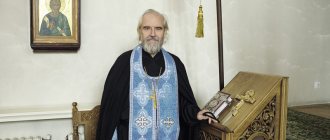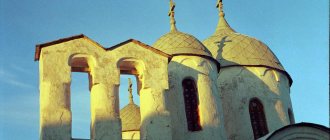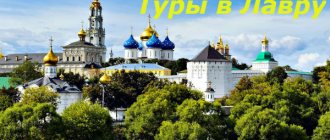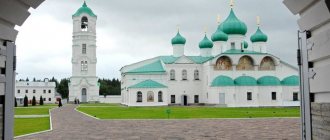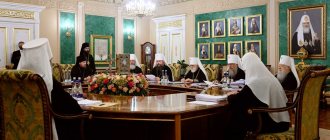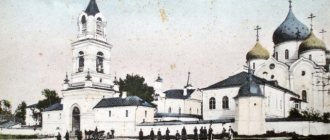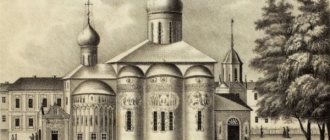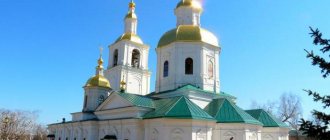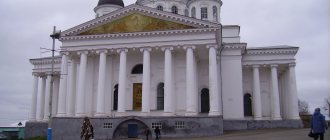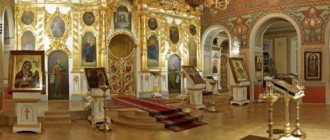The Moscow Metochion of the Holy Trinity Sergius Lavra (also called the Trinity Metochion, the Moscow Metochion or the Moscow Metochion of the Trinity Lavra) is a cultural and religious monument with a long history.
This is the first courtyard of the Trinity-Sergius Lavra and one of the most important spiritual centers. The foundation of the Moscow metochion was laid during the life of St. Sergius of Radonezh.
The walls of the temple are literally saturated with the spirit of those events that will forever go down in history. Riots, baptism of members of the royal family, revolution, Soviet times. We will dive not only into the past, but also tell you what life is like in the Moscow courtyard now.
Panorama of the courtyard complex, Google Maps
Schedule of services for the Moscow Metochion in 2021
Services in the Moscow courtyard of the Holy Trinity Sergius Lavra are held daily.
On weekdays, the midnight office begins at 06:30, the liturgy - at 08:00, at 17:00 - vespers, on weekends and holidays at the same time - all-night vigil. More detailed information about services is available on the metochion’s website.
Schedule of services on the official website of the Moscow Metochion
© Moscow Trinity Compound STSL
Current state[edit]
In 1992, the Trinity Metochion was returned to the Church. With the blessing of His Holiness Patriarch Alexy II, Hieromonk Longin (Korchagin), now Bishop of Saratov and Volsky, revived monastic and parish life here. The first Liturgy at the Compound was celebrated on Easter 1993. And in 1995, the first patriarchal service took place. His Holiness Patriarch Alexy II of Moscow, in concelebration with the Spiritual Council of the Holy Trinity Sergius Lavra, headed by the viceroy, Archimandrite Feognost (Guzikov) and the Lavra choir under the direction of Archimandrite Matthew (Mormyl), performed the Divine Liturgy at the Compound.
Now services are held in three restored chapels of the Church of the Life-Giving Trinity - in the name of the Life-Giving Trinity, in honor of the Vladimir Icon of the Mother of God, in the name of St. Sergius and Nikon, the Radonezh miracle workers. The premises of the Metropolitan Chambers have been completely restored: the House Church has been restored, domes have been erected, paintings have been restored, divine services are held regularly, and the Chambers themselves have become the center of cultural pastime - meetings, lectures and concerts are held here.
The men's choir of the Moscow Compound of the Holy Trinity Sergius Lavra, under the direction of Vladimir Gorbik, sings at the services of the Compound, at Patriarchal services in the cathedrals of the Moscow Kremlin and tours around the world.
The children's choir of the Compound of the Holy Trinity Sergius Lavra performs at concerts with the Capital Symphony Orchestra, the founder, artistic director and chief conductor of which is Vladimir Aleksandrovich Gorbik. Children get acquainted with the lofty images of world musical art in practice.
The structure of the Moscow courtyard of the Trinity-Sergius Lavra
On the territory of the Moscow courtyard there is not only a temple where parishioners come and where services are held. The Moscow Compound is a whole complex that includes the Church of the Life-Giving Trinity and a house church, premises for a Sunday school and library, and museum rooms.
Structure of the courtyard:
- Church of the Life-Giving Trinity - services are held here;
- house temple - cells are located there. The walls are decorated with frescoes depicting St. Sergius of Radonezh;
- Sunday school - classes are held regularly on weekends. Children from 4 to 13 years old go to school;
- choir school - in the Moscow courtyard there are classes in choral singing for children and adolescents from 5 to 15 years old, as well as for men and women;
- theater studio - children, their parents and other parishioners take part in productions and organizing performances. The studio has its own artistic director. For productions, plots are taken from spiritual and Russian classical literature;
- library - the fund contains about 18,000 copies of books, magazines, newspapers, audio and video recordings;
- museum rooms - they regularly host thematic exhibitions;
- department of fabrics and vestments - in the Moscow courtyard there is its own sewing workshop, where cassocks, surplices, cassocks, etc. are made for sale;
- publishing house that has existed since 1995. The literature produced is varied - liturgical books, lives of saints, Orthodox calendars and much more.
The Moscow courtyard complex also includes a warehouse for utensils and a church shop. There is a small garden next to the temple.
©
Patronal holidays[edit]
- Trinity Day
- 50th day after Easter - Icon of the Most Holy Theotokos “Vladimir”
- September 8, July 6, June 3 - Sergius of Radonezh, Venerable
- Cathedral of Moscow Saints, July 18 (Discovery of venerable relics), October 8 (Repose) - Nikon of Radonezh, Venerable
- November 30 - Cathedral of Moscow Saints
– October 18 - Icon of the Most Holy Theotokos “Iverskaya”
- October 26, February 25, May 6
History of the Moscow courtyard
The history of the Moscow metochion of the Trinity-Sergius Lavra began in the 14th century: the monastery was founded during the life of St. Sergius of Radonezh.
The first chronicle mention of the monastery (the complex had this status until 1744) dates back to the time of construction of the stone Church of the Epiphany - 1460. The erected temple was not inferior to the existing masterpieces of architecture. Soon the monastery officially became Epiphany - after the throne of its main church. In 1661, the Church of Theodore Stratilates was erected and consecrated on the territory.
During the 14th–19th centuries, the monastery often found itself at the center of events of national importance: sovereigns often visited the monastery of Sergius of Radonezh, Vasily III baptized his son there, and it was here in 1607 that the townspeople’s nationwide repentance of treason took place. Those who had previously recognized False Dmitry came to the monastery to repent of their sin. The beginning of the reign of the Romanov dynasty is also associated with the courtyard.
In 1764, the monks were forced to leave the monastery: Empress Catherine II signed a decree transferring the land to the state, and the monastery was evicted. The Court Order and the Commandant's House were located there.
After some time, services began to take place in the temple again. Before the revolution, the courtyard was visited more than once by reigning persons - Alexander II and Maria Alexandrovna, Nicholas II.
In Soviet times, a kindergarten was located on the territory of the courtyard, then a music hall, and rehearsals for a symphony orchestra took place. With the departure of Soviet power, the courtyard was restored and in 1992 it was transferred to the Russian Orthodox Church.
Nowadays, services are regularly held in the Moscow Trinity Compound. The main shrine of the monastery is the icon of the Mother of God “It is Worthy to Eat.”
© Moscow Trinity Compound STSL
Russian Orthodox Church
Sretensky Deanery of the Moscow City Diocese
Story
In 1609, by decree of Tsar Vasily Ivanovich Shuisky, the Holy Trinity Lavra of St. Sergius was granted a plot of land in Moscow on the banks of the Neglinnaya River in memory of the Lavra’s heroic stand for the faith and the Fatherland during the Time of Troubles of the Polish-Lithuanian devastation.
The first mention of the Trinity Compound and the wooden Church of the Life-Giving Trinity dates back to 1638. In 1696, a stone Trinity Church was erected on the territory of the Compound.
In 1766, the mentor of the heir to the throne Paul I, Archimandrite Platon (Levshin; †1812), the future Metropolitan of Moscow and Kolomna, became the rector of the Lavra. From that time on, he was actively involved in the improvement of the Trinity Metochion: in 1767, the building of the Metropolitan Chambers was built (architect Vasily Yakovlev) with a house church in honor of the holy supreme apostles Peter and Paul.
From 1815 to 1923, the metochion was the permanent residence of Moscow metropolitans. Saint Philaret (Drozdov; †1867) lived in the courtyard for 46 years (from 1821 to 1867).
Since 1868, the metochion became the residence of St. Innocent (Veniaminov-Popov; †1879), Metropolitan of Moscow and Kolomna, in 1879-82. Metropolitan of Moscow Macarius (Bulgakov) lives here.
During different years of their earthly ministry, Saint Ignatius (Brianchaninov; †1867), Hieromartyr Vladimir (Epiphany; †1918), and Saint Macarius (Nevsky; †1926) visited this place and lived here.
At the Trinity Metochion on November 5, 1917, the future hieromartyr Metropolitan of Kiev and Galicia Vladimir brought the news of his election to the Patriarchal throne to Metropolitan Tikhon (Belavin; †1925) of Moscow and Kolomna. In 1917-22. The Metropolitan Chambers of the Metochion became the residence of the Patriarch of Moscow and All Rus' Tikhon, who was arrested in May 1922.
In 1922, the courtyard was abolished, the buildings were transferred to renovationists, then to secular institutions.
In 1992, by decree of His Holiness Patriarch of Moscow and All Rus' Alexy II, the activity of the metochion was resumed. Hieromonk Longin (Korchagin) was appointed rector.
On July 24, 1993, on the day of remembrance of the Holy Equal-to-the-Apostles Grand Duchess Olga, the first Liturgy took place in the Church of the Life-Giving Trinity - in the Vladimir chapel. On May 1, 1994, on Easter, the first Liturgy was celebrated in the central chapel of the Trinity Church. In the same year, bells were installed on the bell tower of the temple.
In the mid-1990s. The building of the Metropolitan Chambers was returned to the courtyard.
On April 15, 2000, His Holiness Patriarch Alexy II performed the great consecration of the Church of the Life-Giving Trinity.
On June 23, 2011, the first Liturgy was celebrated in the restored house church in honor of the First Hierarchs of Moscow, located in the Metropolitan Chambers.
Temples of the courtyard
- Church of the Life-Giving Trinity with chapels in honor of the Vladimir Icon of the Mother of God and St. Sergius and Nikon of Radonezh;
- home church of the First Hierarchs of Moscow at the Metropolitan Chambers.
Divine service
Midnight Office daily on weekdays at 6.30, Liturgy at 8.00. On Sundays and holidays Liturgy at 7.00 and 9.00. Evening service the day before at 17.00.
How to get there
The Moscow courtyard of the Holy Trinity Sergius Lavra is located in the Troitskaya Sloboda in Moscow. Address: 2nd Troitsky lane, 6, building 9.
Buses
The nearest bus stop is located on Olimpiysky Prospekt (the public transport stop is called “1st Troitsky Lane”). Buses No. 24, , T13 go to it. The distance from the stop to the courtyard is approximately 200 meters.
Public transport stop on the map
Metro
If you get there by metro, the closest stations to the courtyard are “Dostoevskaya” (you will have to walk about one kilometer to the temple) and “Tsvetnoy Boulevard” (about 800 meters to the courtyard). See the location of these stations on the map below.
Moscow metro map
Dostoevskaya and Tsvetnoy Boulevard metro stations on the map
